#online retail trends
Text
The Future of E-commerce: Emerging Technologies and Trends Shaping Online Retail
The world of e-commerce is constantly evolving, with new technologies and trends emerging every year. As consumer behavior shifts and technology advances, it’s essential for online retailers to stay ahead of the curve. In this article, we’ll delve into the future of e-commerce by examining some of the most significant emerging technologies and trends shaping the industry, including virtual…

View On WordPress
#AI personalization#augmented reality#drone deliveries#emerging technologies#ethical retail#future of e-commerce#online retail trends#social commerce#sustainability in e-commerce#virtual reality shopping#voice-activated shopping
0 notes
Text
Everything You Need to Know About Investing
Investing is a vast and intricate world, filled with opportunities, pitfalls, and a plethora of information. Whether you're a seasoned investor or just starting out, there's always something new to learn. Let's dive into the essentials of investing and how you can navigate this financial journey with confidence.
The Foundations of Investing
Before diving deep into the strategies and nuances, it's crucial to understand the basics. Investing is essentially allocating resources, usually money, with the expectation of generating an income or profit. But where do you start?
1. Understanding Your Goals
Every investor has a unique set of objectives. Some might be saving for retirement, while others could be aiming to buy a home or fund their children's education. Knowing your goals will help you tailor your investment strategy accordingly.
2. Risk and Return
There's a fundamental principle in investing: the higher the potential return, the higher the risk. It's essential to assess your risk tolerance and align it with your investment choices. For a deeper dive into risk management, check out Investment Pitfalls Unveiled: How to Avoid Costly Mistakes.
3. Diversification
Don't put all your eggs in one basket. Diversifying your investments across different asset classes can help mitigate risk. This strategy is beautifully explained in The Comprehensive Guide to Index Funds: A Powerful Tool for Diversification and Long-term Growth.
The World of E-commerce and Investing
E-commerce has revolutionized the way we shop and invest. With the rise of online platforms, investing has become more accessible than ever. Here's how the e-commerce landscape intertwines with the world of investing:
Retail Trends: The retail industry is ever-evolving, with new trends emerging regularly. For instance, the new retail trends in Qatar offer a comprehensive insight into the changing dynamics of the market.
Online Safety: As online transactions become more prevalent, it's crucial to ensure safety. Learn how to shop online safely to protect your investments and personal information.
The Magic of Customer Experience: In the world of e-commerce, customer experience is king. Dive into the enchanting e-commerce world and discover how it impacts investment decisions.
Cryptocurrency: The New Frontier
The rise of digital currencies, especially Bitcoin, has added a new dimension to investing. With its decentralized nature and potential for high returns, many are drawn to this digital gold. Explore the empowering world of Bitcoin banking and how it's reshaping the financial landscape.
Time: The Investor's Best Friend
Time is a crucial factor in investing. The power of compounding, where your investments earn returns on returns, can lead to exponential growth over time. Delve into the concept of compounding demystified to harness its potential.
In Conclusion
Investing is a journey, filled with learning, growth, and occasional setbacks. But with the right knowledge, tools, and mindset, it can lead to financial freedom and prosperity. As you embark on this journey, remember to stay informed, make informed decisions, and always keep your goals in sight.
For more insights, tips, and comprehensive guides on various topics, explore the vast collection of articles on Steffi's Blogs. Happy investing!
Note: Always consult with a financial advisor before making any investment decisions.
#Unlock Wealth Secrets#E-commerce Goldmine#Bitcoin Boom#Investing 101 Unveiled#Qatar's Retail Revolution#Risk or Reward? Find Out!#Dive into Digital Currencies#Time's Ticking: Compound Now!#Financial Freedom Fast-Track#Master the Market Mysteries#From Zero to Investment Hero#Online Shopping: Safe or Scam?#Cryptocurrency Craze: Join or Joke?#Diversify and Dominate#Retail Trends: Rise or Ruin?#Customer Experience: Cash or Crash?#Compounding: The Magic Formula#Steffi's Top Investment Tips#Navigate the Investment Labyrinth#E-commerce Explosion: Invest or Ignore?
2 notes
·
View notes
Text
Luxury Plated iPhone Case

#business#seo expert#online shoppping#shopping#amazon#sales#marketing#retail#entrepreneur#onlinestore#united states of america#united states#canada#america#viralpage#trending
3 notes
·
View notes
Text
The Rise of Paid Returns in Online Shopping: Will Shoppers Return to the High Street?
Remember the days when online shopping meant you could order anything, try it on, and return what didn’t fit completely free of charge? Well, it seems those days are behind us. ASOS recently announced that customers will now have to pay for returns. Naturally, this has caused quite a stir in the online shopping world. But the truth is, ASOS isn’t the first to do this, and it’s becoming the norm…
#amazon#ASOS return fees#Brick and mortar vs. online stores#Consumer behaviour in e-commerce#e-commerce#E-commerce consumer habits#E-commerce trends 2024#fashion#Fashion influencers and hauls#High street shopping returns#Klarna and Clearpay shopping#Online retail return charges#Online shopping returns#Online vs. in-store shopping#online-shopping#Paid returns policy#Retail return policies#shopping#Shopping convenience vs. cost
0 notes
Text
https://www.amazonbigstep.com
Most underrated Ecommerce Tech site , i just went through .. ..
#TEMU vs Amazon#E-commerce showdown#Online retail competition#TEMU e-commerce strategy#Amazon marketplace domination#TEMU vs. tech giants#Future of online shopping#Retail giants face off#E-commerce trends#Amazon vs. TEMU comparison
0 notes
Text
Unveiling Insights into the Japan Fashion Ecommerce Market

Key Takeaways:
The Japan Fashion Ecommerce Market is witnessing robust growth, fueled by evolving consumer preferences, technological advancements, and the increasing digitalization of retail. This market presents lucrative opportunities for both domestic and international fashion retailers, with key takeaways including the growing adoption of mobile shopping, the emergence of niche ecommerce platforms, and the integration of innovative technologies to enhance the online shopping experience. As Japan's fashion ecommerce landscape continues to evolve, understanding these key takeaways is essential for businesses aiming to capitalize on this thriving market.
Japan Fashion Ecommerce Market Size is estimated to be valued at US$ 23,238 Mn in 2024 and is expected to reach US$ 61,235 Mn by 2031, exhibiting a compound annual growth rate (CAGR) of 14.8% from 2023 to 2031.
Market Key Trends:
Several key trends are shaping the Japan Fashion Ecommerce Market, reflecting shifts in consumer behavior and industry dynamics. Firstly, there is a growing demand for sustainable and ethical fashion products, driven by increasing environmental awareness among consumers. Ecommerce platforms catering to eco-conscious shoppers are gaining traction, offering a wide range of sustainable fashion options. Additionally, personalization is becoming increasingly important, with retailers leveraging data analytics and AI to deliver tailored shopping experiences. Furthermore, the convergence of online and offline retail channels through omnichannel strategies is on the rise, as retailers seek to provide seamless shopping experiences across multiple touchpoints in the Japan Fashion Ecommerce Market.
Get More Insights On This Topic: Japan Fashion Ecommerce Market
#Japan Fashion Ecommerce Market#Japanese Fashion#Online Shopping#Fashion Retail#Digital Trends#Retail Innovation#Japanese Brands#Ecommerce Growth
0 notes
Text
Unboxing the Best: Insider Tips for Successful Online Shopping
Embark on a journey into the cutting-edge world of online shopping, where innovation and convenience converge to redefine your shopping experience. As we step into 2024, discover exclusive tips that go beyond the ordinary, ensuring your online escapades are not just successful but uniquely tailored to the evolving trends of the digital marketplace.

Immersive Virtual Boutiques:
Say goodbye to traditional online storefronts and hello to immersive virtual boutiques. Expect a surge in visually stunning, 3D shopping environments where you can virtually stroll through aisles, explore product displays, and make selections in an experience that mirrors the real-world excitement of in-store shopping.
Crypto Rewards and NFT Incentives:
Dive into the future of online shopping by exploring platforms that offer cryptocurrency rewards and exclusive non-fungible token (NFT) incentives. Brands are embracing blockchain technology to create limited-edition digital assets and reward loyal customers with unique, collectible items.
Conscious AI-Assisted Shopping:
Unleash the power of AI with a conscience. Look for platforms that not only personalize your shopping recommendations but also consider ethical and sustainable practices. AI algorithms are evolving to align with your values, making your shopping experience both tailored and environmentally conscious.
Biometric Security Measures:
As online security becomes a top priority, anticipate the integration of biometric authentication for secure transactions. Fingerprint scans, facial recognition, and voice authentication are set to become the norm, ensuring your digital shopping experience is not only seamless but also highly secure.
Collaborative Shopping Experiences:
Break away from the solitary nature of online shopping with collaborative experiences. Explore platforms that enable you to shop with friends in real-time, share wishlists, and collectively make decisions. It's a digital shopping spree with a social twist.
AI-Powered Styling Advisors:
Elevate your fashion game with AI-powered styling advisors. These virtual fashion gurus analyze your preferences, body shape, and the latest trends to curate personalized style suggestions. Say goodbye to fashion faux pas and hello to a wardrobe tailored just for you.
Augmented Reality Fitting Rooms:
Revolutionize the way you try before you buy with augmented reality fitting rooms. Visualize how clothing items will look on you in real-time, allowing you to make confident decisions on size, fit, and style without leaving the comfort of your home.
Voice-Activated Price Negotiations:
Take control of your budget with voice-activated price negotiations. Some platforms are integrating AI-driven negotiation tools that allow you to haggle for the best price using your voice. It's a game-changer for securing the most competitive deals.
Interactive Product Storytelling:
Immerse yourself in the narrative of the products you purchase. Look for brands that offer interactive product storytelling, providing insights into the creation process, sourcing of materials, and the artisans behind the scenes. It's a new era of transparency in the world of online retail.
Smart Subscription Services:
Move beyond conventional subscription boxes with smart subscription services. These adaptive subscriptions learn from your preferences, evolving over time to deliver products that align with your changing needs and desires. It's a personalized, ever-evolving shopping experience at your fingertips.
Conclusion:
As you dive into the avant-garde landscape of online shopping in 2024, embrace these exclusive tips to stay ahead of the curve. From virtual boutiques to biometric security measures, the future of online shopping is as dynamic and innovative as ever. Unleash the potential of 2024's digital marketplace and redefine the way you shop with style and sophistication.
Congratulations on your online purchasing,
Check our product www.clickere.in
#ATM Shopping#Biometric Security#Crypto Rewards#Digital Innovation#Future Retail#Online Shopping#Smart Subscriptions#Tech Trends#Virtual Boutiques
0 notes
Text
Analyzing the Shift in Consumer Preferences Post-Pandemic
The pandemic has irrevocably altered the landscape of consumer preferences, presenting both challenges and opportunities for business owners. As the world navigates the aftermath, a significant shift towards online shopping, sustainability, and health-conscious choices has emerged. This evolution in consumer behavior underscores the importance for businesses to adapt and realign their offerings to meet these new demands. Understanding and integrating these preferences into business models will be key in capturing and retaining customer interest in a post-pandemic world.
Digital transformation has accelerated, making e-commerce not just an option but a necessity for retailers. The convenience, safety, and efficiency of online shopping have elevated consumer expectations, pushing businesses to enhance their digital platforms and logistics. Moreover, the rise of social media marketing has changed how brands connect with their audience, emphasizing the need for authentic and engaging online content. For businesses, investing in a robust online presence and e-commerce capabilities is crucial to tap into this shift and drive growth.
Sustainability has come to the forefront of consumer concerns, with a growing demand for eco-friendly products and practices. This shift reflects a deeper awareness of environmental issues and a desire to contribute positively by making responsible purchasing decisions. For business owners, this means prioritizing sustainability not just in products but in operations and messaging. Demonstrating a genuine commitment to environmental stewardship can strengthen brand reputation and loyalty among eco-conscious consumers.
Health and wellness have also gained prominence, influencing a wide range of industries from food and beverage to fitness and leisure. The pandemic heightened awareness around health, leading consumers to seek products and services that support their wellbeing. Businesses have the opportunity to cater to this trend by offering healthier options, transparent product information, and wellness-focused experiences. Aligning with these health-conscious preferences can differentiate a brand and attract a dedicated customer base.
In conclusion, the post-pandemic world presents a new paradigm of consumer preferences that business owners must navigate. Adapting to these changes, from digital adoption and sustainability to health and wellness, is not just beneficial but essential for businesses aiming to thrive. By understanding and responding to these shifts, companies can build a resilient and relevant brand that resonates with today’s consumers.
This article delves into the significant shifts in consumer preferences post-pandemic and outlines the crucial adjustments business owners need to make in response. Highlighting digital transformation, sustainability, and health consciousness as key trends, it provides a roadmap for businesses to adapt and succeed in the evolving market landscape. Through a persuasive and clear narrative, it encourages business owners to embrace these changes, leveraging them as opportunities to enhance their offerings and connect with consumers on a deeper level.
#post-pandemic consumer trends#shift in buying habits#digital transformation in retail#online shopping surge#health and safety priorities in businesses
0 notes
Text
What Is Consumer Research: Methods, Types, Scope & Examples
Explore the world of consumer research with our comprehensive blog. Learn about various research methods, types, and the broad scope of consumer studies. Dive into real-world examples to understand how consumer research impacts businesses and shapes the market landscape. Elevate your knowledge and stay ahead in the dynamic field of consumer insights.
#Consumer research methods#Types of consumer research#Scope of consumer studies#Consumer research examples#Quantitative research in consumer studies#Qualitative approaches in consumer research#Ethical considerations in consumer studies#Consumer behavior analysis#Market research techniques#Demographic analysis in consumer research#Psychographic research methods#Consumer insight generation#Brand perception research#Product testing in consumer studies#Comparative consumer analysis#Cross-cultural consumer research#Technology in consumer studies#Future trends in consumer research#Data-driven consumer insights#Consumer decision-making models#Survey methods in consumer research#Focus group dynamics#Case studies in consumer research#Consumer satisfaction measurement#Trend analysis in consumer studies#Retail environment studies#Consumer feedback and reviews#Online consumer behavior#Social media impact on consumer research#Global consumer trends
0 notes
Text
Wine Woman Whisky Whisperer

Website: https://www.winewomanww.com
Wine Woman Whisky Whisperer specializes in importing exclusive, organic European wines and Japanese whisky. With a focus on eco-friendly and sustainable practices, they offer a unique collection of wines and spirits, alongside private label wines for wholesale. Their services extend to private tastings, degustation events, and hospitality training, emphasizing their commitment to quality and environmental sustainability.
Facebook: https://www.facebook.com/Winewomanww
Instagram: https://www.instagram.com/winewomanwhiskywhisperer/
Keywords:
Japanese distilleries
Hospitality industry training
Wine tasting events
Degustation experience
Australian wine market
Biodynamic wines online
Sustainable wineries
Australian wine market trends
Biodynamic wines for sale
Eco-friendly spirits
European vineyards
Organic wine sales
Private label wine services
Sustainable winemaking practices
Wine event management
Wine event planning
eco friendly spirits
european wine importers
japanese whisky retailers
wholesale wine distribution
sustainable liquor practices
unique wine collection
quality spirits import
wine and whisky expertise
whisky tasting sessions
organic wine varieties
biodynamic wine options
sustainable spirit choices
eco conscious winemaking
imported european wines
authentic japanese whisky
custom label wine services
bulk wine distribution
engaging wine tastings
exquisite degustation experiences
training for hospitality professionals
sustainability in liquor production
rare and unique wine finds
premium spirits imports
wine and whisky connoisseurship
old world charm of european vineyards
japanese artistry in distilleries
wine event coordination
whisky tasting workshops
certified organic wine sales
environmentally friendly spirits
sustainable practices in winemaking
exclusive european wine imports
sought after japanese whiskies
custom branded wine options
wine distribution for businesses
interactive wine tastings
fine degustation experiences
professional training for hospitality
sustainability initiatives in liquor
collectible and unique wines
importing high quality spirits
expertise in wine and whisky
australian wine market insights
exploring european vineyard landscapes
japanese craftsmanship in distilling
whisky tasting masterclasses
organic wine sales online
biodynamic wine selections
eco friendly spirit choices
premier european wine imports
rare japanese whisky finds
private label wine customization
wholesale wine distribution services
exclusive wine tasting experiences
degustation events for enthusiasts
advanced hospitality industry training
liquor sustainability education
limited edition and unique wines
premium imported spirits
wine and whisky aficionado expertise
australian wine market developments
european vineyard terroir
japanese whisky distillation art
wine event coordination services
whisky tasting seminars
certified organic wine selections
biodynamic wines with character
eco conscious spirit offerings
sustainability in artisanal winemaking
european wine import insights
japanese whisky culture appreciation
custom label wine services for businesses
wine distribution partnerships
immersive wine tasting experiences
degustation events for connoisseurs
#Japanese distilleries#Hospitality industry training#Wine tasting events#Degustation experience#Australian wine market#Biodynamic wines online#Sustainable wineries#Australian wine market trends#Biodynamic wines for sale#Eco-friendly spirits#European vineyards#Organic wine sales#Private label wine services#Sustainable winemaking practices#Wine event management#Wine event planning#eco friendly spirits#european wine importers#japanese whisky retailers#wholesale wine distribution#sustainable liquor practices#unique wine collection#quality spirits import#wine and whisky expertise#whisky tasting sessions#organic wine varieties#biodynamic wine options#sustainable spirit choices#eco conscious winemaking#imported european wines
1 note
·
View note
Text
Changing Landscape of European Retail
Written By: Jagriti Shahi

Figure: Growth of retail in Europe
The retail industry in Europe has undergone significant transformations in recent years, driven by changing consumer preferences, technological advancements, and global economic shifts. From traditional brick-and-mortar stores to e-commerce giants, European retail has seen a remarkable evolution. In this article, we will explore the key trends shaping the changing landscape of European retail and how businesses are adapting to stay competitive in this dynamic environment. The retail sector in Europe is the largest in the world, with a turnover of over €2 trillion in 2021. The sector employs over 20 million people and accounts for about 10% of the EU's GDP. The retail sector in Europe is highly fragmented, with a large number of small and medium-sized enterprises (SMEs). However, there are also a number of large multinational retailers operating in the market, such as Carrefour, Tesco, and IKEA.

Figure: Growth of retail in Europe
The retail sector in Europe is facing a number of challenges, including the rise of e-commerce, the changing demographics of consumers, and the increasing adoption of new technologies. The rise of e-commerce is one of the most significant challenges facing the retail sector in Europe. In 2021, online retail sales in Europe reached €768 billion, accounting for 16.1% of total retail sales. This growth is being driven by a number of factors, including the increasing availability of high-speed internet, the growing popularity of mobile shopping, and the convenience of online shopping.
Traditional brick-and-mortar retailers are struggling to compete with the convenience and lower prices of online retailers. In order to survive, traditional retailers are investing in their online presence and offering omnichannel experiences that allow customers to shop online and in-store. The demographics of European consumers are also changing, which is having an impact on the retail landscape. The population is aging, with more people over the age of 65. This group is increasingly active and affluent, and they are looking for different products and services than younger consumers. They are also more likely to shop online.
Another demographic trend is the increasing diversity of the European population. This is leading to a demand for more ethnic food and clothing stores. Retailers are also adapting their marketing and advertising to reach these new customer groups.
New technologies are also having a major impact on the retail landscape. The use of artificial intelligence (AI), augmented reality (AR), and virtual reality (VR) is growing, and these technologies are being used to improve the customer experience in a number of ways. For example, AI can be used to personalize recommendations, AR can be used to try on clothes virtually, and VR can be used to create immersive shopping experiences. The adoption of new technologies is also creating new opportunities for retailers. For example, retailers can use data analytics to track customer behavior and improve their marketing and product offerings. They can also use social media to connect with customers and build relationships.
The future of European retail is uncertain, but it is clear that the industry is undergoing a major transformation. The rise of e-commerce, the changing demographics of consumers, and the increasing adoption of new technologies are all having a major impact on the way people shop. Retailers that are able to adapt to these changes will be the ones that are successful in the future.
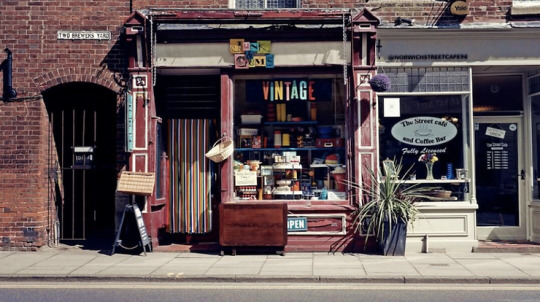
Figure: Brick-and-Mortar stores
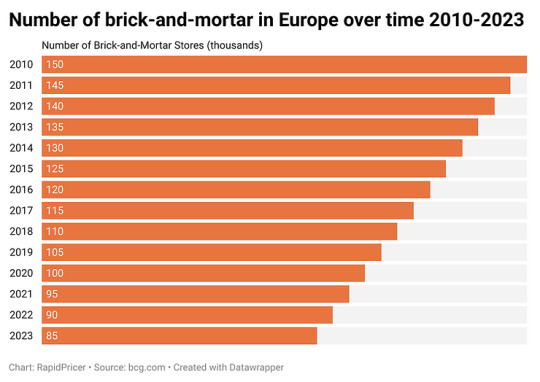
Figure: Number of brick-and-mortar in Europe over time

Figure: Department stores
Department stores: Department stores are large stores that sell a variety of products, such as clothing, home goods, and electronics. Some of the most famous department stores in Europe include Galeries Lafayette in Paris, Selfridges in London, and El Corte Inglés in Madrid.
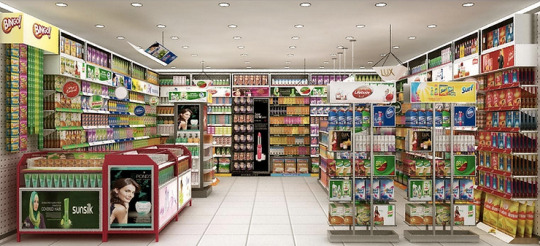
Figure: Independent retailers
Independent retailers: Independent retailers are small, privately owned businesses that sell a variety of products. These retailers often have a strong local presence and offer a unique shopping experience.
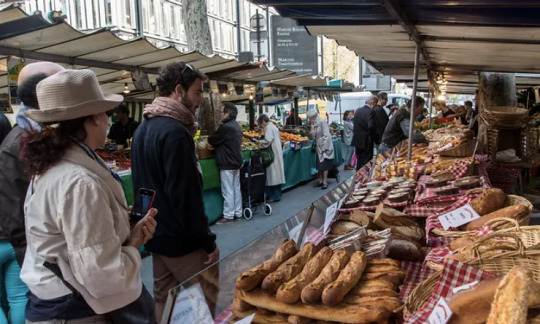
Figure: Markets
Markets: Markets are a great place to find fresh produce, meats, cheeses, and other local products. Many European cities have traditional markets that have been operating for centuries.

Figure: Outlet
Outlet malls: Outlet malls are a great place to find discounted name-brand clothing, shoes, and accessories. These malls are often located in tourist destinations.
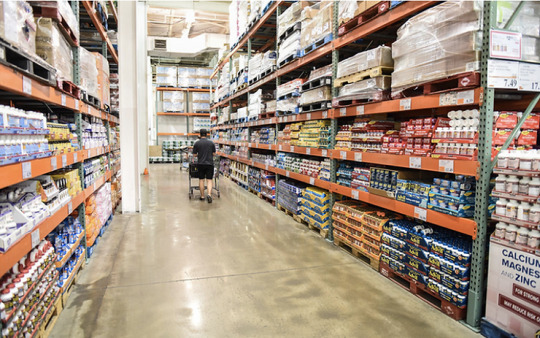
Figure: Warehouse clubs
Warehouse clubs: Warehouse clubs are membership-only stores that sell a variety of products in bulk. These clubs are a great place to find discounts on groceries, household goods, and other items.
Traditional retail is still a major part of the retail landscape in Europe, and it is likely to remain so for the foreseeable future. These stores offer a unique shopping experience that cannot be replicated online. In addition, many traditional retailers are adapting to the changing retail landscape by investing in their online presence and offering omnichannel shopping experiences.
The European Retail Landscape
Europe boasts a diverse and rich retail heritage, with traditional shops, boutiques, and markets dating back centuries. These establishments have played a significant role in local economies, offering consumers a wide range of goods and personalized shopping experiences.
Challenges in the Digital Age: Traditional retail in Europe has felt the impact of the digital age. The rapid growth of e-commerce giants like Amazon, along with the convenience of online shopping, has led to a decline in foot traffic at brick-and-mortar stores. Consumers now have access to a vast array of products with the click of a button, making it essential for traditional retailers to adapt.
The Omnichannel Approach: Many traditional European retailers are responding to the digital challenge by adopting an omnichannel approach. This strategy combines physical stores with an online presence, offering consumers a seamless shopping experience. Retailers are investing in e-commerce websites, mobile apps, and in-store technology to bridge the gap between offline and online shopping.
Customer Experience and Personalization: One advantage traditional retailers have over e-commerce is the ability to provide a unique and personalized customer experience. Many European consumers still value the tactile, sensory experience of shopping in a physical store. Traditional retailers are focusing on creating welcoming and interactive environments, offering personalized service, and curating their product selections to cater to local tastes.
Sustainability and Localism: In response to consumer demand for sustainability and ethical shopping, traditional European retailers are emphasizing their commitment to local sourcing and environmentally friendly practices. Some are rediscovering the benefits of locally-produced goods, promoting them as eco-friendly alternatives to mass-produced items. This aligns with the rising trend of supporting local businesses and reducing the carbon footprint associated with global supply chains.
Cultural and Historical Significance: Traditional retail establishments often hold cultural and historical significance in European communities. Many have been in operation for generations, serving as cornerstones of local culture. These stores are cherished by residents and tourists alike, and efforts are made to preserve their historical authenticity while integrating modern retail practices.
Government Support: Some European governments recognize the importance of preserving traditional retail and are offering support through grants, subsidies, and regulatory measures. These initiatives aim to bolster traditional retail against the encroachment of e-commerce and maintain the vibrancy of city centers.
Conclusion
Traditional retail in Europe is at a crossroads. While it faces challenges from the digital age and changing consumer preferences, it also has unique advantages rooted in history, culture, and personalized shopping experiences. To thrive in today's retail landscape, traditional retailers must embrace technology, adopt an omnichannel approach, focus on customer experience, and align with sustainability and localism trends. In doing so, traditional European retail can not only survive but also continue to offer consumers a distinctive and cherished shopping experience that reflects the rich tapestry of Europe's retail heritage. By adapting to the evolving market while preserving their unique qualities, traditional retailers can continue to play a vital role in the continent's commercial landscape.
The changing demographics of consumers
The demographics of European consumers are also changing, which is having an impact on the retail landscape. The population is aging, with more people over the age of 65. This group is increasingly active and affluent, and they are looking for different products and services than younger consumers. They are also more likely to shop online.
Another demographic trend is the increasing diversity of the European population. This is leading to a demand for more ethnic food and clothing stores. Retailers are also adapting their marketing and advertising to reach these new customer groups.
Here are some specific examples of how the changing demographics of consumers are impacting the retail industry in Europe:
The aging population is leading to a demand for more accessible and convenient shopping options. This is driving the growth of online grocery delivery and click-and-collect services.
The increasing diversity of the population is leading to a demand for more ethnic food and clothing stores. This is also leading to a demand for products and services that cater to the needs of diverse cultures, such as halal food and bilingual customer service.
The rise of the digital native is leading to a demand for more personalized and engaging shopping experiences. This is driving the growth of mobile commerce and augmented reality (AR) shopping.
The changing role of women is leading to a demand for more flexible shopping hours and options for online shopping. This is also leading to a demand for more products and services that are designed for women, such as maternity clothing and baby products.
The growing importance of sustainability is leading to a demand for more sustainable products and services. This is driving the growth of organic food, fair trade clothing, and recycled packaging.
The increasing adoption of new technologies
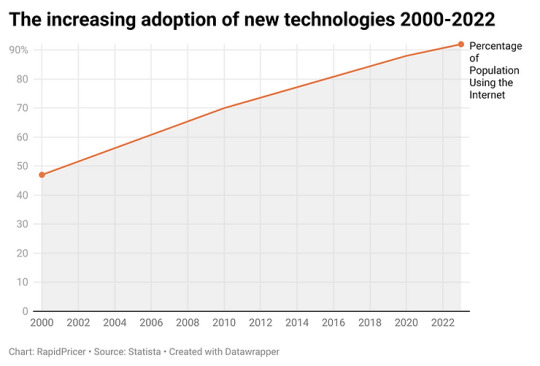
Figure: The increasing adoption of new technologies
As you can see, the percentage of people in Europe using the internet has been increasing steadily over the past two decades. This is due to a number of factors, including the increasing availability of high-speed internet, the falling cost of computers and smartphones, and the growing popularity of online services.
The increasing adoption of new technologies is having a major impact on the retail industry in Europe. Here are some of the key technologies that are being adopted by retailers in Europe:
Artificial intelligence (AI): AI is being used to improve a variety of tasks in the retail industry, such as customer service, inventory management, and fraud detection. For example, AI can be used to analyze customer data to personalize recommendations, or to predict which products are likely to be in high demand.
Augmented reality (AR): AR is being used to create immersive shopping experiences that allow customers to try on clothes virtually or see how furniture would look in their home. For example, IKEA has an AR app that allows customers to see how its furniture would look in their living room.
Virtual reality (VR): VR is being used to create even more immersive shopping experiences that allow customers to virtually visit stores and try on products. For example, Amazon has a VR store that allows customers to browse its products and make purchases.
Internet of Things (IoT): IoT is being used to connect devices and collect data about customer behavior. This data can be used to improve a variety of tasks, such as inventory management and customer service. For example, retailers can use IoT sensors to track the movement of products in stores and to identify when products are running low.
Blockchain: Blockchain is being used to create secure and transparent supply chains. This can help retailers to ensure the authenticity of their products and to track their products from the source to the customer. For example, Walmart is using blockchain to track the supply chain of its food products.
These are just some of the key technologies that are being adopted by retailers in Europe. The adoption of these technologies is helping retailers to improve their efficiency, personalize the customer experience, and create a more sustainable supply chain.
E-Commerce Dominance
One of the most profound shifts in European retail has been the rise of e-commerce. Consumers now have the convenience of shopping online from the comfort of their homes, and this trend has been accelerated by the COVID-19 pandemic. Major players like Amazon, Alibaba, and local champions such as Zalando and ASOS have expanded their reach across Europe, reshaping consumer behavior and expectations. Retailers have had to invest heavily in their online presence, enhancing websites, mobile apps, and supply chain logistics to meet the demand for digital shopping. Additionally, omnichannel strategies have become essential, allowing consumers to seamlessly switch between online and offline shopping experiences.
E-commerce dominance refers to the growing market share of online retailers over traditional brick-and-mortar stores. This trend is being driven by a number of factors, including the increasing availability of high-speed internet, the growing popularity of mobile shopping, and the convenience of online shopping. In Europe, e-commerce sales are expected to reach €768 billion in 2022, accounting for 16.1% of total retail sales. This growth is being driven by the increasing adoption of online shopping by consumers across all demographics.
There are a number of reasons why e-commerce is becoming so dominant. First, the availability of high-speed internet has made it possible for consumers to shop online quickly and easily. Second, the popularity of mobile shopping has made it possible for consumers to shop online from anywhere. Third, the convenience of online shopping is unmatched by traditional brick-and-mortar stores. Consumers can shop online 24/7, compare prices from different retailers, and have products delivered to their door. The rise of e-commerce is having a major impact on the retail industry. Traditional brick-and-mortar stores are facing increasing competition from online retailers, and many are struggling to compete. In order to survive, traditional retailers need to adapt to the changing retail landscape by investing in their online presence and offering omnichannel shopping experiences.

Figure: Share of online retail sales in Europe over time
As you can see, the share of online retail sales in Europe has been increasing steadily in recent years. This is due to the increasing popularity of online shopping, which is more convenient and offers a wider selection of products. The share of online retail sales is expected to continue to increase in the coming years. However, it is important to note that not all countries are affected equally. For example, the share of online retail sales is higher in Northern Europe than in Southern Europe. The future of online retail in Europe is bright. The growth of online shopping is being driven by a number of factors, including the increasing availability of high-speed internet, the growing popularity of smartphones and tablets, and the increasing convenience of online shopping.
Sustainability and Ethical Consumption
The European retail landscape is witnessing a significant shift towards sustainability and ethical consumption. Consumers are becoming increasingly aware of the environmental and social impact of their purchases. Retailers are responding by adopting eco-friendly practices, sourcing sustainable products, and promoting transparency in their supply chains.
Fashion brands, in particular, have made strides in sustainable fashion, with initiatives like "slow fashion" and clothing rental services gaining popularity. European consumers are favoring products that are produced responsibly and have a lower environmental footprint, and retailers are aligning their strategies with these values.
Personalization and Data Analytics
Data analytics and artificial intelligence are playing a crucial role in the transformation of European retail. Retailers are harnessing the power of big data to gain insights into consumer behavior, preferences, and shopping habits. This data-driven approach allows them to personalize marketing efforts, optimize inventory management, and enhance the overall shopping experience.
Personalized recommendations, targeted advertising, and tailored promotions are becoming the norm in the industry. Retailers are using predictive analytics to forecast trends and adjust their product offerings accordingly, ensuring they stay ahead of consumer demands.
Pop-Up Stores and Experiential Retail
While online shopping continues to grow, physical stores are not becoming obsolete. Instead, retailers are reimagining the in-store experience to attract and engage customers. Pop-up stores and experiential retail spaces are gaining popularity, offering unique and immersive experiences that cannot be replicated online.
These temporary stores allow retailers to test new products and connect with customers on a more personal level. They often incorporate interactive elements, such as virtual reality experiences or live demonstrations, to create memorable moments for shoppers.
Cross-Border Expansion
European retailers are increasingly looking beyond their home markets for growth opportunities. Cross-border expansion has become a viable strategy for many companies seeking to tap into new customer bases and diversify revenue streams. The European Union's single market has facilitated this expansion by reducing trade barriers and harmonizing regulations.
Furthermore, technology has made it easier for retailers to reach international customers through e-commerce platforms and digital marketing. As a result, many European brands are expanding their presence into neighboring countries and even outside of Europe, creating a more competitive and globalized retail landscape.
Post COVID European Retail
The retail industry in Europe is undergoing a period of change after COVID. The pandemic has accelerated the shift to online shopping, and brick-and-mortar stores are struggling to compete. Retailers are responding by adopting new technologies, such as AR and VR, and by offering more convenient shopping experiences, such as BOPIS. The industry is also focusing on sustainability, as consumers are increasingly demanding sustainable products and services.
Conclusion
The changing landscape of European retail is characterized by the rapid growth of e-commerce, a focus on sustainability and ethical consumption, data-driven personalization, experiential in-store experiences, and cross-border expansion. Retailers that adapt to these trends and embrace digital transformation are likely to thrive in this dynamic environment.
The future of European retail will continue to be shaped by evolving consumer preferences and technological innovations. To stay relevant, retailers must remain agile, customer-centric, and committed to ethical and sustainable practices. As the industry continues to evolve, it will be exciting to see how retailers innovate and compete in this ever-changing landscape.
About RapidPricer
RapidPricer helps automate pricing, promotions and assortment for retailers. The company has capabilities in retail pricing, artificial intelligence and deep learning to compute merchandising actions for real-time execution in a retail environment.
Contact info:
Website: https://www.rapidpricer.com/
LinkedIn: https://www.linkedin.com/company/rapidpricer/
Email: [email protected]
#European Retail Industry#Retail Trends in Europe#E-commerce Growth#Brick-and-Mortar Stores#Omnichannel Retailing#Digital Transformation#Consumer Behavior#Sustainability in Retail#Retail Technology#Online Marketplaces#Supply Chain Disruptions#Post-Pandemic Retail#Retail Innovation#Mobile Shopping#Data Analytics in Retail#Cross-Border Shopping#Pop-Up Stores#Customer Experience#Retail Competition#Retailer Partnerships#Retail Regulations#Future of Retail in Europe#Retail Challenges#Local vs. Global Retailers#Retail Adaptation Strategies
0 notes
Text
🥳 US$340.56 Reps M46077 Women'S handbags 31X28X14Cm
✨
Search 🔍<SKU: WR35EFA32>👈 in #WeeReplica with "Gussie" code👉can enjoy $5 Off $200+, $10 Off $300+,$15 Off $400+💐✨✨✨


0 notes
Link
Discover the Best Shopify Stores for Clothing & Fashion: Unleashing Style and Innovation
The world of fashion and clothing has witnessed a remarkable shift towards online shopping, and Shopify has become a go-to platform for many successful clothing and fashion brands. In this blog post, we will showcase some of the best Shopify stores in the clothing and fashion industry. These stores not only exemplify stunning designs and captivating aesthetics but also offer exceptional user experiences and innovative features that redefine the online shopping journey. Get ready to be inspired by these fashion-forward Shopify stores that are making waves in the industry.
#ShopifyStores#shopify#shopify commerce#shopify retail#web development#web developers#web developing company#ecommerce#ecommerce development#ecommerce developers#clothing#fashion#tech#tech news#tech trends#technology#technology trends#website#b2c#online shopping
0 notes
Text
i am quite surprise to know that a big dual has been started at the home ground of Amazon. Temu is really giving a hard time to the giant. A healthy tussle get started.. wooh. which will definitely give benefit to customers.
#TEMU vs Amazon#E-commerce showdown#Online retail competition#TEMU e-commerce strategy#Amazon marketplace domination#TEMU vs. tech giants#Future of online shopping#Retail giants face off#E-commerce trends#Amazon vs. TEMU comparison#alternative#home
1 note
·
View note
Text
💥US$116.1 Reps Ladies Patchwork Tote Bag 30X22Cm
👋
Search 🔍<SKU: WR35EF4FB4>👈 in #WeeReplica with "Gussie" code👉can enjoy $5 Off $200+, $10 Off $300+,$15 Off $400+💐
✨




#totebag#handbags#cheapest#online#trending#repsshoulderbag#retailers#weereplica#repsguccibags#onlineshopping
0 notes
Text
Beyond Borders: A Global Perspective on Online Shopping
Online shopping has become a global phenomenon in today's interconnected world, bringing with it a plethora of opportunities for both consumers and businesses. This blog examines the worldwide terrain of internet purchasing, illuminating the patterns, obstacles, and prospects that emerge when trade transcends national boundaries.

The Rise of Cross-Border E-Commerce:
Examine the rise in international e-commerce and its effects on the world economy and talk about the elements that are propelling this expanding trend, such as changes in consumer behavior and technology improvements.
Cultural Influences on Online Shopping:
Examine how cultural variations affect the habits and preferences of internet shoppers.
Give instances of effective international e-commerce systems that have adapted to a range of cultural quirks.
Challenges in Cross-Border Transactions:
For both customers and businesses, navigating the intersections of cross-border transactions poses a variety of difficulties. Language obstacles can make it difficult to communicate effectively, and complicated currency conversions make financial operations more complicated. Diverse legal and regulatory environments throughout nations present formidable obstacles, necessitating that companies carefully manage compliance environments. Delays and uncertainty are caused by customs processes and overseas shipping operations, which negatively affects the general consumer experience. Innovation in solution-finding, technological progress, and a sophisticated comprehension of the various worldwide market situations are necessary to overcome these obstacles. Notwithstanding these challenges, the benefits of expanding into new areas and reaching a larger global audience make the journey through cross-border e-commerce worthwhile in terms of strategic endeavors.
Global E-Commerce Giants:
A few titans stand out in the huge world of international e-commerce, changing the way consumers make cross-border purchases. Amazon is a leading online retailer that has not only taken over the Western markets but has also consciously extended its influence globally by utilizing its extensive product selection and effective delivery methods. On the opposite side of the world, cloud services, digital payments, and e-commerce are all seamlessly blended by Alibaba, the Chinese e-commerce behemoth that has revolutionized the Asian market and beyond. In addition to competing on a worldwide scale, these behemoths also accommodate local tastes, tongues, and cultures, demonstrating the flexibility and scalability needed to prosper in the varied environment of cross-border e-commerce. Their accomplishments highlight how crucial it is to recognize and address each customer's specific needs.
Payment Methods and Security Across Borders:
In the world of international e-commerce, it's critical to manage the wide range of available payment options and make sure your security measures are strong. When it comes to payment methods, different regions have different preferences. These can range from digital wallets and credit cards to other payment options exclusive to a given nation. It is imperative for firms aiming to develop trust and accessibility to accommodate these desires. In addition, it is critical to solve security issues in order to provide customers confidence when they interact internationally. Technological advancements in multi-factor authentication, encryption, and secure payment gateways are essential to strengthening the worldwide e-commerce experience. In order to create a smooth and reliable cross-border payment ecosystem and guarantee a safe and enjoyable buying experience for customers everywhere, it is imperative to strike a balance between ease and security.
Economic Impacts of Global Online Shopping:
Online shopping has a significant impact on the global economy and is a disruptive force. Positively, it promotes economic growth by providing them with unparalleled access to a worldwide customer base that surpasses geographical constraints. This promotes global trade and creates opportunities for employment, especially in industries like digital marketing and logistics. Engaging in cross-border electronic commerce can serve as a stimulant for economic growth in poorer countries, thereby mitigating global economic inequality. But there are still many obstacles to overcome, like unequal market access and worries about ethical labor practices. Harnessing the full economic potential of global internet shopping requires striking a balance between the development opportunities and resolving these challenges.
Future Trends and Innovations:
Looking ahead to the future of e-commerce reveals a world molded by cutting edge developments and trends. Virtual reality (VR) and augmented reality (AR) have the potential to completely transform the shopping experience by enabling customers to virtually try things on before they buy them. In order to customize the online shopping experience to individual interests, artificial intelligence (AI) will be a key component of personalized suggestions and improved customer care.
Blockchain technology promises to improve transaction security and transparency. The combination of these technologies guarantees an easy, engaging, and safe international buying experience. Eco-friendly methods, such as fewer packaging and green supply chains, will probably take center stage in the sector as sustainability becomes more and more important. Online shopping will evolve into a dynamic digital marketplace that combines technology, personalisation, and sustainability, rather than just being transactional.
Check our product www.clickere.in
#Online Shopping#Global Commerce#Future of Retail#E-Commerce Trends#Digital Innovation#Global Marketplace
0 notes